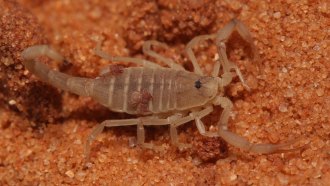Life
-
 Neuroscience
NeuroscienceA new device let a man sense temperature with his prosthetic hand
A device that can be integrated into prosthetic hands capitalizes on phantom sensations to enable users to sense hot and cold.
By Simon Makin -
 Animals
AnimalsHere’s how many shark bites there were in 2023
The chance of being bitten by a shark is still incredibly slim, according to a new report from the Florida Museum of Natural History.
-
 Animals
AnimalsThe first known scorpion to live with ants carries mini hitchhikers
Small arachnids hitch a ride on the scorpion, possibly to get inside food-rich ant nests.
By Jake Buehler -
 Plants
PlantsHere’s why blueberries are blue
Nanostructures in a blueberry’s waxy coating make it look blue, despite having dark red pigments — and no blue ones — in its skin, a new study reports.
-
 Plants
PlantsThis weird fern is the first known plant that turns its dead leaves into new roots
Cyathea rojasiana tree ferns seem to thrive in Panama’s Quebrada Chorro forest by turning dead leaves into roots that seek out nutrient-rich soil.
-
 Paleontology
PaleontologyA rare 3-D tree fossil may be the earliest glimpse at a forest understory
The 350-million-year-old tree, which was wider than it was tall thanks to a mop-top crown of 3-meter-long leaves, would look at home in a Dr. Seuss book.
-
 Planetary Science
Planetary ScienceBacteria that can make humans sick could survive on Mars
Experiments suggest that common illness-causing microbes could not only survive on the Red Planet but also might be able to thrive.
By Adam Mann -
 Paleontology
Paleontology50 years ago, trilobite eyes mesmerized scientists
Decades of research has confirmed that for such simple creatures, trilobites had astoundingly complex eyes.
-
 Animals
AnimalsExplore the expected life spans of different dog breeds
An analysis of dogs in the United Kingdom found that breeds like miniature dachshunds have the longest life spans while bulldogs have the shortest.
-
 Microbes
MicrobesBird flu viruses may pack tools that help them infect human cells
Bringing along their own ANP32 proteins may give avian flu viruses a jump-start on copying themselves to adapt to and infect humans and other animals.
-
 Animals
AnimalsParrots can move along thin branches using ‘beakiation’
The movement involves swinging along the underside of branches with their beaks and feet, similar to how primates swing between trees.
-
 Life
LifeInsects flocking to artificial lights may not know which way is up
Insects may use light to figure out where the ground is. Artificial lights send them veering off course, data from high-speed infrared cameras suggests.